 Natural
wetlands are the single largest source of methane, a potent greenhouse gas estimated
to account for about one-quarter of Earth's current excess warming. Now, in
an odd twist that highlights the complex nature of interactions between Earth's
systems, researchers have found that acid rain is significantly suppressing
the global emission of methane from wetlands.
Natural
wetlands are the single largest source of methane, a potent greenhouse gas estimated
to account for about one-quarter of Earth's current excess warming. Now, in
an odd twist that highlights the complex nature of interactions between Earth's
systems, researchers have found that acid rain is significantly suppressing
the global emission of methane from wetlands.Vincent Gauci collects air samples to analyze methane from a wetland area in the eastern highlands of Moray, Scotland. Researchers now say that acid rain may reduce the emission of methane from wetland areas. Courtesy of Vincent Gauci.
Acid rain contains sulfate derived from the burning of coal, particularly "dirty coal" with high sulfur content. In wetland environments, the additional sulfate input gives sulfate-reducing microbes a competitive advantage over their methane-producing kin. The process "results in a reduction in methane production and therefore a reduction in emission," says Vincent Gauci, a biogeochemist at Open University in Milton Keynes, United Kingdom, and lead author of a recent study on acid rain in wetlands.
"This is actually far from the first time we've seen links between microbial and global processes — most of the important processes that regulate the global system are microbial," says Josh Schimel, a biogeochemist at the University of California, Santa Barbara. "What we often don't do is make an explicit quantitative link between the small and large scales."
In field experiments, Gauci and colleagues found that high rates of sulfate deposition suppressed methane emissions in wetlands by 30 to 40 percent. The researchers also modeled the process using global sulfur emissions and sulfate deposition from 1960 to 2080.
The model showed that 8 percent less methane is currently being emitted from natural wetlands than would be emitted without acid rain. Using estimates from the Intergovernmental Panel on Climate Change of future sulfur emissions, the model showed a reduction in wetland methane emissions due to acid rain of 15 percent by 2030.
Although this particular microbial process was previously known — for example, saltwater marshes with sulfate from seawater are not significant methane sources, whereas freshwater marshes are — it had not previously been quantified in a way that made its global significance understood.
That quantification of the link between the methane and sulfur budgets likely will prove important for future climate models. "It may be an order of magnitude estimate of what the impacts are likely to be," Schimel adds, but "it is a much stronger quantitative link than we'd been able to develop before."
Another novel aspect of the study, which was published in the Aug. 24 Proceedings of the National Academy of Science, is that the researchers were able to assess "whether or not an interaction at the microbial scale was significant at the global scale," Gauci says. "Our results show that it is."
The researchers say that the effect of sulfate deposited by acid rain had been overlooked as an important component of the methane budget. "The impact of sulfate hadn't been fully examined until now," Gauci says, "whereas components of the methane budget, such as termites and oxidation in dry soils, have been very well-studied."
The study also suggests that global warming in wetlands is not responsible for the rise in atmospheric methane since the late 19th century, because acid rain is offsetting the effects, Gauci says. "Overwhelmingly, the increase is likely due to anthropogenic output of methane,” he says — “emissions from rice agriculture, cattle, exploitation of natural gas reserves and landfills."
Nonnatural wetlands, such as rice paddies, are a significant and growing source of methane. How methane emissions from rice paddies will respond to acid rain is an important question, Gauci says. "Asia is forecast to increase rice production to feed a growing population, which should mean increases in methane emission," he notes, "but Asia is also forecast to be impacted by more and more acid rain as the region develops economically."
This is not the first time sulfur pollution has been found to counterbalance elements of climatic warming. Sulfate aerosols reflect the sun's rays, thus acting to cool the planet. However, people should not embrace the notion that sulfate emissions and acid rain are good things, researchers say.
"It has long been known that acid rain damages natural ecosystems," Gauci says. "But our findings suggest that small amounts of pollution may also have a positive effect in suppressing this important greenhouse gas."

